

12 Ways to Support ESL Students in the Mainstream Classroom. You have a new student, and he speaks no English.
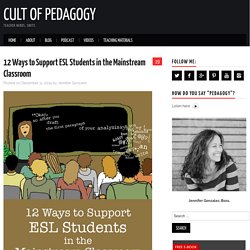
His family has just moved to your town from Japan, and though he receives English as a Second Language (ESL) support, he will also be sitting in your room every day to give him more exposure to his new language. How can you be a good teacher to someone who barely understands you? According to the National Center for Education Statistics, an average of 9 percent of students in U.S. public schools are English Language Learners (ELLs); that number is closer to 14 percent in cities. Although many of these students start off in high-intensity, whole-day English programs, most are integrated into mainstream classrooms within a year, well before their English language skills would be considered proficient.
How prepared are you to teach these students? Below, three ESL teachers tell us what they know about the things regular classroom teachers can do to improve instruction for ELL students. SixKeyStrategiesELL. EJ1083695. With increasing international enrollments, faculty grapple with implications for classrooms. In the past few years it’s not been unusual for Don Bacon to walk into his classroom on day one and find that half his students are from China.
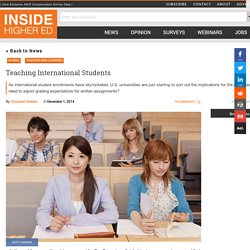
“I realized I’m going to have to change how I do some things,” said Bacon, a professor of marketing at the University of Denver. “If you do some things that don’t work great for 10 percent of your students but work for the other 90 percent you can probably keep doing that and be successful as a teacher,” he said (though he noted that wouldn’t be optimal either). “When it gets to be half the class and you’re realizing you’re not meeting the needs of half the class, that’s a problem.” As U.S. campuses have dramatically increased their international student populations in recent years, more and more faculty members are encountering a different demographic of student than they are used to – or at least they’re encountering that demographic more frequently. Learn Spanish, French, German, Portuguese, Italian and English for free. GSET Certification. The Global Scale of English Test (GSET) is a scientifically designed, accurate test to measure your English level, from complete beginner right through to advanced.

Evaluate your English level across your speaking, listening, reading and writing skills. The test provides an overall numerical score using the Global Scale of English (GSE). This is the first truly global measure of your English level, providing a granular and accurate score from 10 to 90. You can also match your GSE score to the Common European Framework of Reference. Minutes after completing the test you will receive your score and will be able to download an official busuu-Pearson Certificate. To learn more about the GSE, go to www.english.com/gse. If you have any questions, please send us an email at team@busuu.com. Institutes. Solutions: Professional Development. Research-Based Professional Development for Teachers of English Learners It is critical that teachers of English learners (ELs) gain the knowledge and skills needed to effectively teach English language skills and academic content.
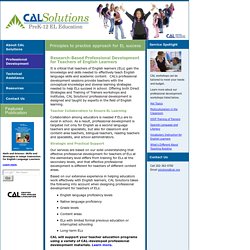
CAL’s professional development sessions provide teachers with the conceptual knowledge and diverse learning strategies needed to help ELs succeed in school. Offering both Direct Strategies and Training of Trainers workshops and institutes, CAL Solutions’ professional development is designed and taught by experts in the field of English learning. English Language Learner University (ELL-U) Services. The Center for Applied Linguistics has provided language and cultural orientation services to educators, service providers, and businesses for over 50 years.
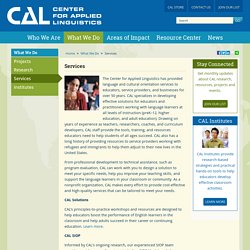
CAL specializes in developing effective solutions for educators and practitioners working with language learners at all levels of instruction (preK–12, higher education, and adult education). Drawing on years of experience as teachers, researchers, coaches, and curriculum developers, CAL staff provide the tools, training, and resources educators need to help students of all ages succeed. November 2010. Do's & Don'ts For Teaching English-Language Learners. The number of English-Language Learners in the United States is growing rapidly, including many states that have not previously had large immigrant populations.

As teachers try to respond to the needs of these students, here are a few basic best practices that might help. We have found that consistently using these practices makes our lessons more efficient and effective. We also feel it is important to include a few "worst" practices in the hope that they will not be repeated! Modeling Do model for students what they are expected to do or produce, especially for new skills or activities, by explaining and demonstrating the learning actions, sharing your thinking processes aloud, and showing good teacher and student work samples. Strategies and Resources for Supporting English-Language Learners. "The hardest part of living in a different country is the language barrier.
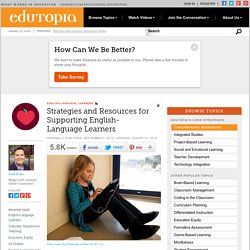
Because you know you have to learn the language in order to survive. " – Betina Johnson Being an English-language learner in the United States is no honeymoon. Efforts to support ELLs have often been well meaning but misinformed. Indeed, a lot of assumptions about how to serve ELLs need to be checked. UC Berkeley experts Margaret Bridge and Bruce Fuller offer three examples of these faulty assumptions: The expectation that Mexican-American English-language learners would enter U.S. schools with inadequate social competence turned out not to be realized.